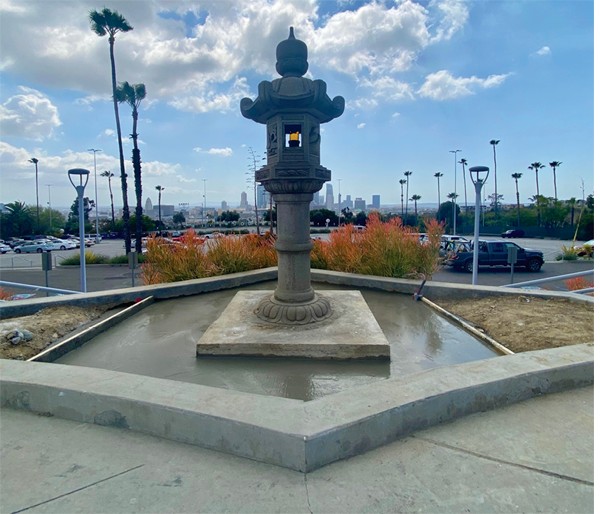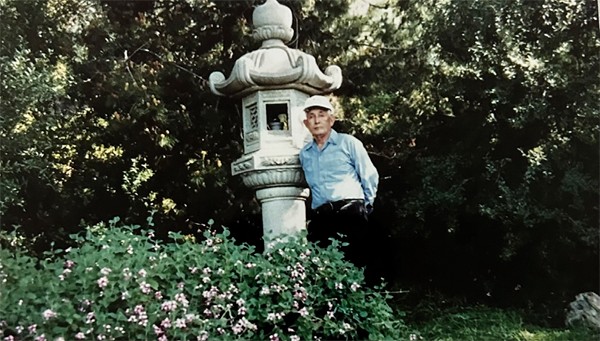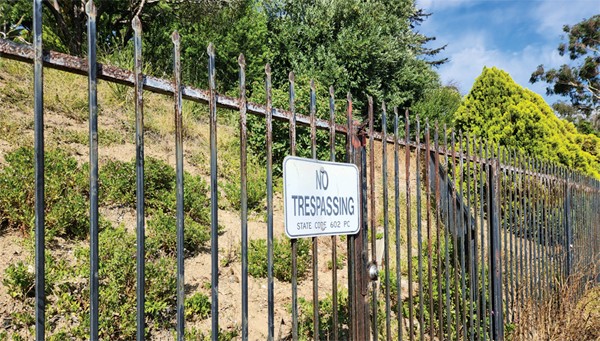Rekindling the Light: The Japanese Stone Lantern at Dodger Stadium
This article was written by Russ Speiller
This article was published in Dodger Stadium: Blue Heaven on Earth (2024)
Frank Ego visits the Japanese lantern outside Dodger Stadium. (Courtesy Kimi Ego.)
The story of how this lantern came to be at Dodger Stadium begins with a 1956 Brooklyn Dodgers tour of Japan. Based on both the success of previous US team tours of Japan and the Brooklyn Dodgers claiming victory as the 1955 World Series champions, Japanese baseball officials reached out to owner Walter O’Malley to attract the team to come to their country to play a series of exhibition games after the 1956 season. The timing was perfect, as O’Malley was looking to increase the size of the Dodgers’ worldwide audience; hence, he jumped at the opportunity to take his team’s brand to Japan.1
On the Japanese side, the two instrumental men who arranged for these tours were Matsutarō Shōriki (正力 松太郎) and Sotaro Suzuki (鈴木 惣太郎. Born on April 11, 1885, Shōriki rose to become a media mogul as owner of the Yomiuri Shimbun newspaper, as well as owner of the Yomiuri Giants baseball team, leading to his ultimate recognition as the “father of Japanese professional baseball.”2
Upon introduction of professional baseball in Japan, Suzuki became an acclaimed sportswriter for the Yomiuri Shimbun, reporting on American baseball. He wrote several books, notably Baseball in America in 1929 and Babe Ruth in 1948. Having been partially educated in the United States at Columbia University, Suzuki helped Shōriki arrange visits of US all-stars to Japan, including Charlie Gehringer, Jimmie Foxx, Lou Gehrig, and Babe Ruth in 1931 and 1934. After World War II, believing it would help heal his country, Suzuki worked tirelessly to ensure that Japanese baseball resumed. Shōriki sent him to New York to meet with O’Malley about organizing the 1956 tour. Suzuki’s importance to Japanese and US baseball relations was commemorated in 1968 with his induction into the Japanese Baseball Hall of Fame.3
The success of the 1956 tour went beyond just the record of the Dodgers’ team, which finished with 14 wins, 4 losses, and 1 tie, as it spurred a long-standing relationship between the Dodgers and Japan, beginning with O’Malley and Shōriki.4 In the spring of 1957, a small contingent from the Yomiuri Giants, accompanied by Sotaro Suzuki, accepted O’Malley’s invitation to train with the Dodgers at their Vero Beach, Florida, Dodgertown spring-training complex.
Afterward, Suzuki and O’Malley continued to correspond. O’Malley invited Sotaro and his wife, Toku, to attend the grand opening of Dodger Stadium on April 9, 1962. Suzuki’s appreciation for both the VIP invitation and the relationship with the Dodgers was so great that he wanted to give the team a significant and meaningful gift. Inspired by a photograph of a stone lantern observed at a friend’s home in Japan, Suzuki commissioned the Kasuga (“springtime” in Japanese) stone lantern, which was placed as the centerpiece in the Japanese garden on the Dodger stadium grounds.
In a May 19, 1965, letter to O’Malley, Sotaro Suzuki wrote:
My Dear Mr. O’Malley:
I have been very busy since I came back to Japan, but I feel great and have found everything o.k.
After thorough investigation and research, I have found a reliable manufacturers of the “Toro” (stone lantern) to be dedicated to the Dodger Stadium in memory of our being invited to the Grand Opening on April 9th, 1962 as guests, which Toku and myself are always thinking one of the greatest honored prouds in our life. The manufacturers are in Nagoya Prefecture who are very popular of their skill and good workmanship to make that kind of Stone Lantern and are regarded one of the best in Japan. I have ordered of them a Lantern about 8 feets high a few days ago. It takes about 3 months to be complete. So I figure that the Lantern will arrive in Los Angeles in about four months. This is just a brief information I can tell you about our dedication of the lantern to the Stadium, but will give you some more informations very shortly. To-morrow we are going to our country home, where we will stay about 5 days to rest and to attend some private affairs. I have to write letters to Terry and Peter, but will do it after I come back Yokohama home again.
Trusting this letter will find you and Mrs. O’Malley and every one of your family in the very best humor and spirits,
Yours very truly,
Sotaro5
Constructed by the well-known Shimizugumi Stone Works Company stone-carving business, located in the Aichi prefecture of Japan, the stone lantern gift for the Dodgers was sculpted in Okazaki City, near Nagoya.
In Japanese culture, “Toro are traditional lanterns made from either wood, stone, or metal. In their original form, stone lanterns embody the five elements of Buddhist cosmology. The closest piece to the ground represents the earth (chi); the next part on top of it represents water (sui). The portion encasing the lantern’s light represents the fire (ka). The air (fu) and the spirit (ku) are symbolized by the two upper sections that are close to the sky. Such lanterns are also a metaphor for the ephemerality of life: after death, our physical bodies will go back to their elemental and original form.”6
Fully constructed, the Kasuga stone lantern was 8 feet tall, weighed 3,921 pounds and needed to be shipped to Los Angeles in six sections during the winter of 1965. Inscribed on the back of the lantern base were the words “To commemorate the opening of Dodger Stadium on April 9, 1962. Donated by Sotaro and Toku Suzuki, Guests.”7 The traditional-style Japanese garden in which the stone lantern was housed was designed and maintained by award-winning head landscaper Mitch Inamura, who handled many of the Dodger Stadium landscaping projects.8 Reaching the garden meant climbing a steep hill where one would encounter river-rock paths, Japanese-style cut pine trees, and two cherry blossom trees.
For many years, O’Malley visited the garden on a regular basis, sitting on a bench that faces the ballpark and clearing his head. O’Malley had plants and trees from the Vero Beach facility planted around the lantern.9
During the 1990s, a Los Angeles resident, Frank Ego, made weekend visits to help maintain and care for the Japanese garden.10 (Ego died in April 2000.) What compelled him to make these visits? In an email interview in May 2023, his daughter, Kimi, shed light on her father’s deep love for and connection to the garden.
Born in Long Beach, California, on May 31, 1921, Frank Ego made several trips back and forth between Japan and California throughout his youth. When Japan and the United States went to war, like many other Japanese Americans on the West Coast, he was interned, at the Manzanar Internment Camp in Independence, California.
Returning to Japan in 1946 after World War II ended, Ego followed Japanese baseball and attended Yomiuri Giants games. He also read the sports columns of Yomiuri Shimbun’s sportswriter Sotaro Suzuki. It was during a visit to Suzuki in his office in Yokohama in the late 1940s that Frank’s life changed forever.
Returning to the. United States in the 1950s, Frank settled in Gardena, California, with his wife and three children. He continued communicating with Suzuki, who would mail Frank the Yomiuri sports pages for over 10 years. In 1962 Frank Ego attended the Dodger Stadium opening day ceremony alongside Suzuki.
Sotaro introduced Ego to Walter O’Malley and his son Peter. Ego and the O’Malley family bonded over a love for horticulture, culminating in a visit by Frank to the O’Malley home, where he later planted cherry blossom trees. Upon retiring from gardening, Ego became a volunteer caretaker for the Japanese garden and stone lantern throughout the 1990s. He made the 20-mile trip from his home in Gardena to Dodger Stadium each weekend. Proud of his work as a gardener, he cherished his time alone in the Japanese garden, planting cherry blossom (sakura) and pine trees.11
In 1998 Walter O’Malley’s son Peter sold the Dodgers to the Fox Entertainment Group, headed by Robert Murdoch. Five years later, the stone lantern was rededicated in a ceremony that posthumously recognized Frank Ego for his work maintaining the garden and stone lantern. Former Dodgers manager Tommy Lasorda spoke during the ceremony, recalling that Walter O’Malley used to picnic at the Japanese garden site.12
In 2004 the Fox Entertainment Group sold the Dodgers to Frank McCourt, who later stood next to the stone lantern and proclaimed, “The lantern contains a light, and the light is a symbol of our enduring relationship with Japan.”13
In 2012 the Guggenheim Baseball Management group purchased the Dodgers from McCourt. The new owners continued to honor Japanese-American ties, most notably via annual heritage days held at Dodger Stadium. Festivities over the years have included jersey giveaways for fans, an exhibition titled “Baseball’s Bridge to the Pacific: Celebrating the Legacy of Japanese American Baseball,” and performances by Japanese drumming ensembles.14
The Japanese garden symbolized the strong relationship between the Japanese and USA baseball cultures. Fenced off, 2023. (Courtesy of Todd Anton.)
However, while the relationship between the Dodgers and Japan has remained strong since 2012, maintenance of the Japanese garden did not. Photos from 2023 and fan chatter depict a hidden (secret) garden surrounded by a fence with a “No Trespassing” sign on the gate. Online references to the garden, such as Reddit chats, give the impression that existence of the garden and lantern have become something of an urban legend.15
One possible explanation for the lack of maintenance might be found in the fact that the current Dodgers ownership group doesn’t own the parking lots outside the ballpark or the land where the garden and lantern reside. Those lots were retained in ownership by former owner McCourt.16 There also were issues of accessibility and security under the Americans with Disabilities Act.
In 2016 Japanese American mystery writer Naomi Hirahara published the novel Sayonara Slam, in which the main character, elderly gardener Mas Arai, is told of the Dodger Stadium Japanese garden.17
“I’m Smitty Takaya.” The white-haired man extended his right hand.
“Mas. Mas Arai.”
“Maybe you can take a look at our Japanese garden someday?” Mas frowned. Maybe his ears weren’t working either. Who ever heard of a Japanese garden in Dodger Stadium?
“One was dedicated out there past the edge of the parking lot. You could draw a line from home plate to centerfield and you’ll find it out there.”
Later in the novel, Mas Arai goes to the garden. …
When he finally reached the edge, he came face to face with a tall, black iron fence with a sign that was menacing in its simplicity: “No Trespassing.” The gate, which was too high for him to scale, had a simple lock that was probably easy to pick.But he didn’t have to go to such lengths, because with one jiggle, the gate opened.
He was able to see the broken cement stairs that took him up the dried-out hill. Did they ever bother to water this area?
When he finally reached the top, Mas felt weak in the knees. It wasn’t the climb that did it. It was what he saw. Dead, uprooted pine trees. Stones thrown haphazardly like giant dice. Dead grass. If a garden could bleed, this one would be covered in blood.
A toro, a Japanese stone lantern, was the only evidence that something artful had once lived here. It was large, maybe ten feet tall. These things were not cheap; Mas knew because he’d acquired smaller versions for the “Oriental” gardens some of his customers had requested in the past. With the fallen trees beside it, the toro seemed like a lone survivor in a war zone.
Mas felt the loneliness creep into his bones. Who had ravaged — or perhaps, more appropriately, ignored — this Japanese garden? He stumbled around the bleak area one more time while the sky quickly lost light.
In late March of 2024, as this essay reached final printing status, the Dodgers announced that the Japanese stone lantern has been moved to a prominent location on the top deck of Dodger Stadium. Dodgers president Stan Kasten stated that “The Los Angeles Dodgers are extremely excited to display a remarkable monument from our past that showcases our long-term relationship with Japan and Japanese baseball. Now that we are making the lantern more visible and more accessible, our fans will have a wonderful opportunity to connect with this part of our history on a personal level.”18
RUSS SPEILLER lives in Cincinnati with his wife, Lisa, and their two children. A lifelong Yankees fan whose father filled him with stories of the 1961 “M&M boys,” Russ holds a chemical engineering degree from the University of Pennsylvania. Having joined SABR in February of 2023, Russ has discovered the pure joy of researching and writing about the great game of baseball. He completed his first BioProject work (Pat Venditte), submitted multiple articles to the Turnstyle literary arts journal, and is proud to make his first SABR book contribution, the start of many more to come!
The historic Japanese stone lantern was moved to a more prominent location at Dodger Stadium’s Top Deck before Opening Day 2024. (Mark Langill / Los Angeles Dodgers)
Sources
The author would like to greatly thank Brent Shyer, vice president of special projects for O’Malley Seidler Partners LLC, who provided both documentation on the stone lantern and Japanese garden, as well as a soon-to-be-published biography of Sotaro Suzuki. Mr. Shyer also provided numerous photographs of the Japanese garden and stone lantern.
The author would also like to thank Kimi Ego, whose correspondences by email provided valuable information on her father, Frank Ego, a gentleman who poured love and care into the Dodger Stadium Japanese garden until his passing.
Notes
1 Mark Langill, “Virtual Talk – 1956 Dodgers’ Tour of Japan: Setting the Stage for Nomo,” YouTube Video, July 3, 2020, Japanese American National Museum Talk, 3:09 to 3:35, https://www.youtube.com/watch?v=UrH5iGNW-hc.
2 https://www.baseball-reference.com/bullpen/Matsutaro_Shoriki
3 Brent Shyer, “Sotaro Suzuki Bio,” May 2023. Unpublished.
4 Don Daijiro Kanase, “The Dodgers’ Japan Connections: From the 1956 Japan Tour to Hideo Nomo.” Discover Nikkei, Nikkei Chronicles #9 – More Than a Game: Nikkei Sports, July 9, 2020, https://discovernikkei.org/en/journal/2020/7/9/dodgers-tour/.
5 Brent Shyer, “Stone Lantern Is Focal Point of Traditional Japanese Garden at Dodger Stadium,” www.walteromalley.com.
6 Ann Walther “What Are Toro? Discovering Japanese Lanterns,” January 7, 2022, https://japanobjects.com/features/japanese-lanterns.
7 Shyer, “Stone Lantern Is Focal Point of Traditional Japanese Garden at Dodger Stadium.”
8 Shyer, “Stone Lantern Is Focal Point of Traditional Japanese Garden at Dodger Stadium.”
9 Carter Cromwell, “Japanese Stone Lantern Is a Dodger Stadium Hidden Gem,” JapanBall, May 31, 2023, https://japanball.com/articles-features/baseball-around-the-world/japanese-stone-lantern-is-a-dodger-stadium-hidden-gem/. Accessed December 21, 2023.
10 Shyer, “Stone Lantern Is Focal Point of Traditional Japanese Garden at Dodger Stadium.”
11 Kimi Ego, email correspondence with author pertaining to Frank Ego, May 29, 2023.
12 Rafu staff and wire reports, “An Appetite for Life, Amore, for All Things Dodger Blue.” Rafu Shimpo, January 11, 2021, https://rafu.com/2021/01/an-appetite-for-life-amore-for-all-things-dodger-blue/.
13 Carter Cromwell, “Japanese Stone Lantern Is a Dodger Stadium Hidden Gem,” JapanBall, May 31, 2023, https://japanball.com/articles-features/baseball-around-the-world/japanese-stone-lantern-is-a-dodger-stadium-hidden-gem/. Accessed December 21, 2023.
14 Rico Cabrera Sr., “Dodgers Celebrate Japanese Heritage Night.” East LA Sports Scene, June 14, 2022, https://eastlasportsscene.com/dodgers-celebrate-japanese-heritage-night/.
15 Captain Dana, “The Abandoned Japanese Garden Out in the Parking Lot,” Reddit, February 2023, https://www.reddit.com/r/Dodgers/comments/112qgjd/the_abandoned_japanese_garden_out_in_the_parking/.
16 Jeff Snider, “Former Dodgers Owner Frank McCourt Is Trying to Build Apartments Close to Dodger Stadium,” Dodgers Nation, February 10, 2023, https://dodgersnation.com/former-dodgers-owner-frank-mccourt-is-trying-to-build-apartments-close-to-dodger-stadium/2023/02/10/.
17 Naomi Hirahara, Sayonara Slam: A Mas Arai Mystery (Los Angeles, Prospect Park Books, 2021), Loc 384, 391, 396, 403 [Kindle Edition].
18 Mark Langill, “Historic Japanese Lantern Tops Park,” Dodger Insider, March 27, 2024, https://dodgers.mlblogs.com/historic-japanese-lantern-tops-park-7367267e8588. Accessed March 31, 2024.




